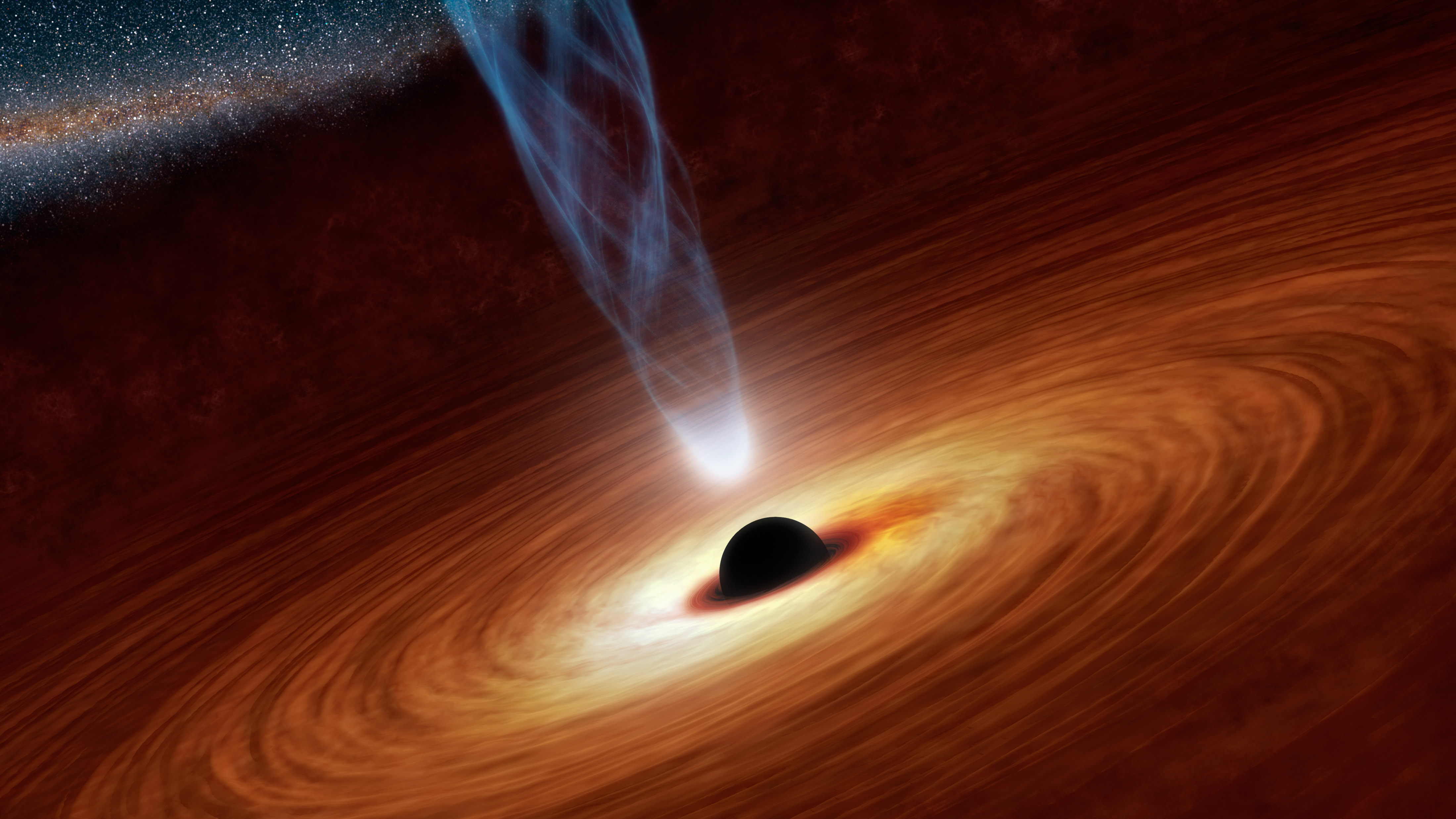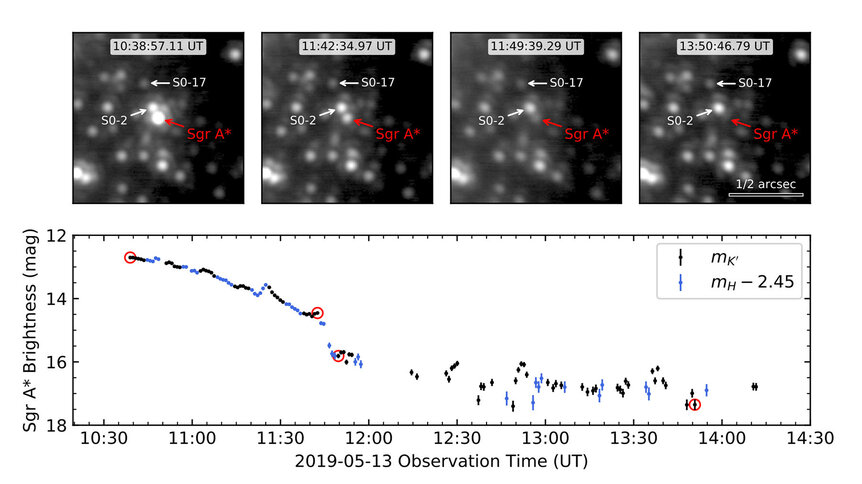Create a free profile to get unlimited access to exclusive videos, sweepstakes, and more!
The supermassive black hole in our galaxy recently erupted… and we don't know why

In the exact center of our Milky Way galaxy sits a black hole. And not just any black hole, but a big one, what we call a supermassive black hole. At over 4 million times the Sun's mass, yeah, the name is apt.
It's usually pretty quiet, but in May 2019 it erupted, blasting out a pretty decently terrifying flare (Note: We're in absolutely no danger, since it's 26,000 light years away!) as astronomers watched.
The question is, why? Well, you know me by now: Let me give you a wee bit of background first.
We think every big galaxy has an SMBH (as those in the know call supermassive black holes), ranging from a few million to many billions of times the Sun's mass. These beasts form along with the galaxy, and both can affect each other's growth and behavior.
In some galaxies, gas and dust fall into the center, feeding the black hole. The material forms a huge disk, sometimes hundreds of light years across. Close to the center, friction heats the disk up to incredible temperatures, so it glows fiercely, becoming so luminous that it can outshine the hundreds of billions of stars in the galaxy itself!
Those are called active galaxies, and happily the Milky Way galaxy is not among them. We call ours quiescent, meaning it's not blasting our radiation. But that doesn't mean it's actually quiet…
Astronomers routinely monitor our supermassive black hole, which is called Sgr A* (literally pronounced "Sagittarius A star" (the "star" part is for historical reasons), or sometimes "Saj A star" for short). We have observations of it going back decades.
In May 2019, a team of astronomers was using the Keck 10-meter telescope to monitor Sgr A* in near infrared, just outside what our eyes can see (at wavelengths of 1.64 and 2.12 microns, where the reddest light our eyes can see is about 0.75 microns). What they saw in their data was astonishing: A very large flare was erupting from the black hole. They caught it as it was already fading, unfortunately, but it was still bright, as this animation shows:
Whoa! You can see the flare already in progress, fading over just a few hours. This was the brightest flare ever seen at these wavelengths, in fact. It dropped in brightness by a factor of 75 in just a couple of hours, and at one point dropped by a factor of 9 in just two minutes.
I did a little bit of math, and I find that very roughly, at its brightest, this flare was well over 2,000 times more luminous than the Sun at this wavelength — and mind you, they caught it after it peaked, so it's not clear how bright it actually got.
Sgr A* is known to fluctuate quite a bit, so the astronomers looked at these observations statistically to compare them with previous observations, and found that the odds of this flare happening just as a random fluctuation are extremely low, like 1 in 2,000. So it appears that something unusual happened at the black hole, something different, to cause it to flare this brightly.
What could it be?
Well, there are a couple of suspects.
Sgr A* isn't alone there in the center of our galaxy. For one thing, there are quite a few stars orbiting our Milky Way's monster. Most take decades to orbit it once, but one, called S2, gets closer than any other known star (it's the star immediately above Sgr A* in the video). Every 16 years, its elliptical orbit drops it a mere 20 billion kilometers from the SMBH. In human terms that's a long way — about four times the distance of Neptune from the Sun — but the gravity of Sgr A* is so ridiculously strong that it accelerates that star to a whopping 7,650 kilometers per second at its closest. That's 2% the speed of light!
The last pass was just last year, in May 2018. Astronomers observed it intently for a number of reasons, one of which was to check on some weird predictions of Einstein's Theory of Relativity (which, naturally, came through with flying colors). While that was all very cool, it's possible that this recent flare is tied to S2 somehow. It's a massive star, and such stars blow a wind of subatomic particles, just like the solar wind but much denser. If the wind is dense enough, and fell into the black hole, perhaps this is the cause of the flare…? However, the astronomers looked into that and determined it's unlikely S2's wind is strong enough to create such a big flare.
It's also possible that the close pass of the star gravitationally perturbed some of the gas around Sgr A*, causing an unusually large amount to fall in. That's harder to determine; perhaps in 15 years, after the next pass, we'll be able to see if this happens again.
The other suspicious character is an object called G2, and to be honest no one knows exactly what it is. It was thought at first to be a dust cloud, because it gives off a similar signature of light in the infrared. It moves around Sgr A* on a 260 year orbit, and in 2014 it skimmed pretty close to the black hole, passing it by only about 30 billion km. That's close enough that a small dust cloud should have been torn apart by the tides from the SMBH… but it appeared to survive the encounter! So it may be a cloud with a small star in the middle, which holds it together. Another idea is that it started out life as a tight binary star, and sometime in the past repeated encounters with Sgr A* caused the two stars to merge. This would also blow off a lot of dust.
Either way, if G2 is shedding material, it too might orbit the black hole on a similar path. If a bigger blob of this stuff fell down onto Sgr A* (maybe due to S2?) then that would be a candidate for the source of the flare.
There are other possibilities, like an asteroid or comet stripped from a star system falling into the black hole; the gravity would tear it apart, flinging some material away while gobbling down the rest. This too could cause a bright flare.
I'll note that flares in other wavelengths have been seen in the past; in X-rays there are incredible flares, some creating jumps of a factor of 100,000 in the luminosity of X-rays coming from Sgr A*! These typically happen a few times per century and last for a few years. Just a few days ago the Neil Gehrels Swift satellite detected a large flare in X-rays from Sgr A*, where it blasting out over 30 times the Sun's total output of energy across the electromagnetic spectrum. Several other smaller flares have been detected by Swift recently as well. These may be related to the May infrared event. Or they may not be. We just don't know.
So it's not clear why this happened, or when it will happen again. So, the only thing to do is keep an eye on the black hole, so to speak, and keep watching it. Unfortunately, we're rapidly approaching the time of year when the Sun passes through Sagittarius, making observations like this impossible. We'll just have to wait a few months before starting up again. Hopefully, if Sgr A* decides to throw a tantrum again, it'll wait for us to be able to see it.
My thanks to Tuan Do, the lead astronomer on the paper about these observations, for graciously answering my questions about them.



























